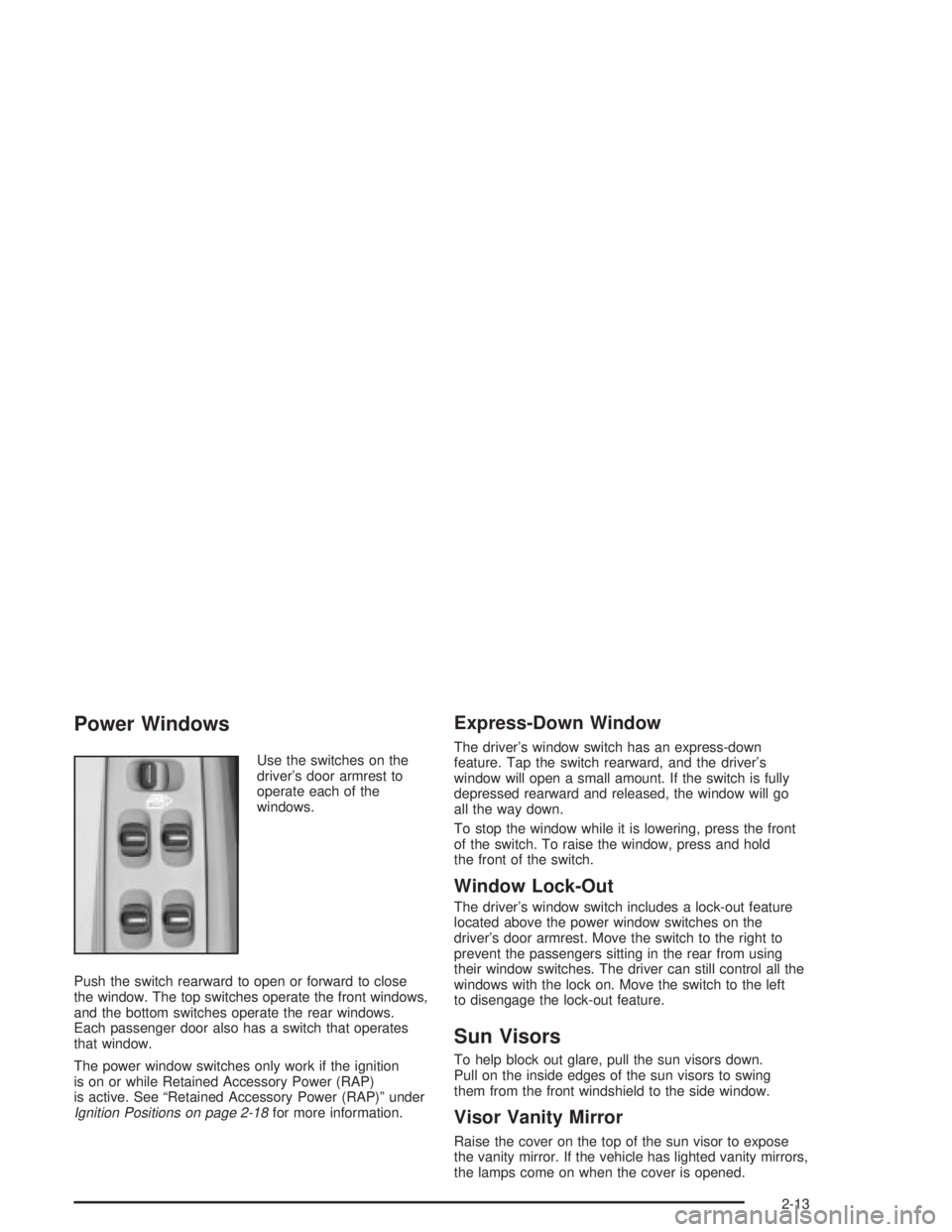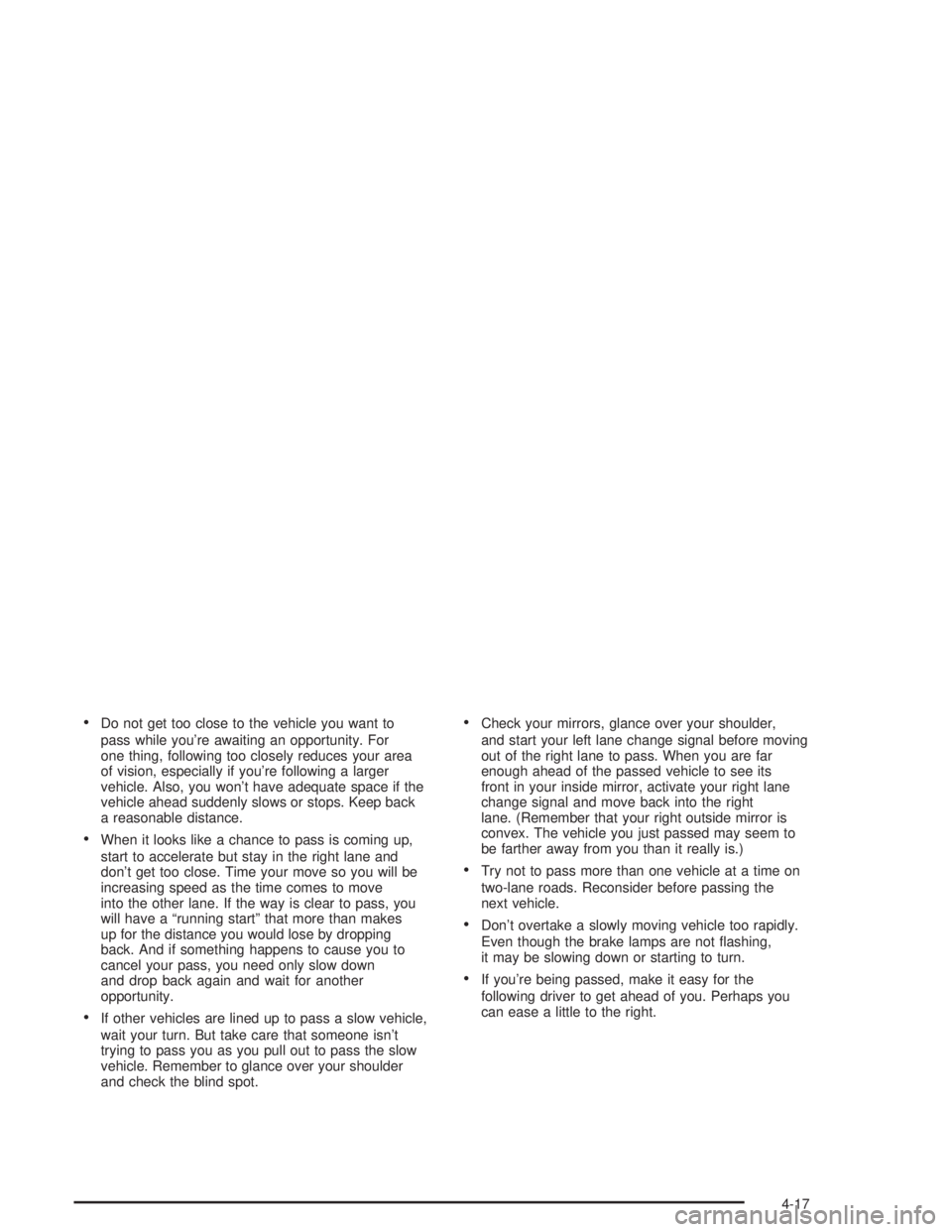2004 PONTIAC GRAND PRIX mirror
[x] Cancel search: mirrorPage 1 of 432

Seats and Restraint Systems........................... 1-1
Front Seats
............................................... 1-2
Rear Seats
............................................... 1-8
Safety Belts
.............................................1-10
Child Restraints
.......................................1-29
Air Bag Systems
......................................1-48
Restraint System Check
............................1-56
Features and Controls..................................... 2-1
Keys
........................................................ 2-2
Doors and Locks
....................................... 2-7
Windows
.................................................2-12
Theft-Deterrent Systems
............................2-14
Starting and Operating Your Vehicle
...........2-18
Mirrors
....................................................2-33
OnStar
žSystem
......................................2-35
Storage Areas
.........................................2-36
Sunroof
..................................................2-39
Instrument Panel............................................. 3-1
Instrument Panel Overview
.......................... 3-2
Climate Controls
......................................3-25
Warning Lights, Gages and Indicators
.........3-31
Driver Information Center (DIC)
..................3-45
Audio System(s)
.......................................3-88Driving Your Vehicle....................................... 4-1
Your Driving, the Road, and Your Vehicle
..... 4-2
Towing
...................................................4-33
Service and Appearance Care.......................... 5-1
Service
..................................................... 5-3
Fuel
......................................................... 5-4
Checking Things Under the Hood
...............5-10
Headlamp Aiming
.....................................5-56
Bulb Replacement
....................................5-59
Windshield Wiper Blade Replacement
.........5-67
Tires
......................................................5-68
Appearance Care
.....................................5-90
Vehicle Identi®cation
.................................5-98
Electrical System
......................................5-99
Capacities and Speci®cations
...................5-104
Normal Maintenance Replacement Parts
......5-105
Maintenance Schedule..................................... 6-1
Maintenance Schedule
................................ 6-2
Customer Assistance Information.................... 7-1
Customer Assistance Information
.................. 7-2
Reporting Safety Defects
............................ 7-9
Index................................................................ 1
2004 Pontiac Grand Prix Owner ManualM
Page 65 of 432

Keys...............................................................2-2
Remote Keyless Entry System.........................2-4
Remote Keyless Entry System Operation...........2-5
Doors and Locks.............................................2-7
Door Locks....................................................2-7
Power Door Locks..........................................2-8
Last Door Closed Locking................................2-8
Programmable Automatic
Door Locks.................................................2-9
Lockout Protection..........................................2-9
Leaving Your Vehicle......................................2-9
Trunk..........................................................2-10
Windows........................................................2-12
Power Windows............................................2-13
Sun Visors...................................................2-13
Theft-Deterrent Systems..................................2-14
Content Theft-Deterrent.................................2-14
PASS-Key
žIII ..............................................2-15
PASS-KeyžIII Operation...............................2-16
Starting and Operating Your Vehicle................2-18
New Vehicle Break-In....................................2-18
Ignition Positions..........................................2-18
Starting Your Engine.....................................2-19Engine Coolant Heater..................................2-20
Automatic Transaxle Operation.......................2-22
Parking Brake..............................................2-27
Shifting Into Park (P).....................................2-28
Shifting Out of Park (P).................................2-30
Parking Over Things That Burn.......................2-30
Engine Exhaust............................................2-31
Running Your Engine While
You Are Parked........................................2-32
Mirrors...........................................................2-33
Manual Rearview Mirror.................................2-33
Manual Rearview Mirror with OnStar
ž..............2-33
Outside Power Mirrors...................................2-34
Outside Convex Mirror...................................2-34
OnStar
žSystem.............................................2-35
Storage Areas................................................2-36
Glove Box...................................................2-36
Overhead Console........................................2-36
Front Seat Storage Net.................................2-37
Center Console Storage Area.........................2-37
Assist Handles.............................................2-38
Convenience Net..........................................2-38
Sunroof.........................................................2-39
Section 2 Features and Controls
2-1
Page 77 of 432

Power Windows
Use the switches on the
driver's door armrest to
operate each of the
windows.
Push the switch rearward to open or forward to close
the window. The top switches operate the front windows,
and the bottom switches operate the rear windows.
Each passenger door also has a switch that operates
that window.
The power window switches only work if the ignition
is on or while Retained Accessory Power (RAP)
is active. See ªRetained Accessory Power (RAP)º under
Ignition Positions on page 2-18for more information.
Express-Down Window
The driver's window switch has an express-down
feature. Tap the switch rearward, and the driver's
window will open a small amount. If the switch is fully
depressed rearward and released, the window will go
all the way down.
To stop the window while it is lowering, press the front
of the switch. To raise the window, press and hold
the front of the switch.
Window Lock-Out
The driver's window switch includes a lock-out feature
located above the power window switches on the
driver's door armrest. Move the switch to the right to
prevent the passengers sitting in the rear from using
their window switches. The driver can still control all the
windows with the lock on. Move the switch to the left
to disengage the lock-out feature.
Sun Visors
To help block out glare, pull the sun visors down.
Pull on the inside edges of the sun visors to swing
them from the front windshield to the side window.
Visor Vanity Mirror
Raise the cover on the top of the sun visor to expose
the vanity mirror. If the vehicle has lighted vanity mirrors,
the lamps come on when the cover is opened.
2-13
Page 97 of 432

Mirrors
Manual Rearview Mirror
Use the control, located at the bottom, to change the
mirror from the day to the night position. To reduce
glare from headlamps behind you while driving at night,
turn the control to the right. To return the mirror back
to the day position, turn the control to the left.
Manual Rearview Mirror with
OnStar
ž
If your vehicle has this feature, use the control,
located at the bottom of the mirror, to change the
mirror from the day to the night position. To reduce
glare from headlamps behind you while driving at night,
turn the control to the right. To return the mirror to
the day position, turn the control to the left.There are two map lamps located on the bottom of the
mirror. Each lamp is turned on and off by pressing
the button next to the lamp.
There are also three OnStaržbuttons located at the
bottom of the mirror face. See your dealer for more
information on the system and how to subscribe
to OnStar
ž. SeeOnStaržSystem on page 2-35for
more information about the services OnStaržprovides.
2-33
Page 98 of 432

Outside Power Mirrors
The power mirror controls
are located near the
driver's window, on the
driver's door armrest.
Move the top control to the left to adjust the driver's
side outside mirror. Move the control to the right
to adjust the passenger's side mirror. The center
position turns the power control off and will not allow
the mirrors to move if the control pad is touched.
The round control pad adjusts the angle of the selected
outside mirror. Press the arrows on the control pad in the
direction that you want the mirror to go. Adjust each
mirror so that you can see a small portion of the side of
your vehicle and the area behind your vehicle.
Outside Convex Mirror
Your passenger's outside rearview mirror is convex.
A convex mirror's surface is curved so you can see more
from the driver's seat.
{CAUTION:
A convex mirror can make things (like other
vehicles) look farther away than they really are.
If you cut too sharply into the right lane, you
could hit a vehicle on your right. Check your
inside mirror or glance over your shoulder
before changing lanes.
2-34
Page 253 of 432

·Do not get too close to the vehicle you want to
pass while you're awaiting an opportunity. For
one thing, following too closely reduces your area
of vision, especially if you're following a larger
vehicle. Also, you won't have adequate space if the
vehicle ahead suddenly slows or stops. Keep back
a reasonable distance.
·When it looks like a chance to pass is coming up,
start to accelerate but stay in the right lane and
don't get too close. Time your move so you will be
increasing speed as the time comes to move
into the other lane. If the way is clear to pass, you
will have a ªrunning startº that more than makes
up for the distance you would lose by dropping
back. And if something happens to cause you to
cancel your pass, you need only slow down
and drop back again and wait for another
opportunity.
·If other vehicles are lined up to pass a slow vehicle,
wait your turn. But take care that someone isn't
trying to pass you as you pull out to pass the slow
vehicle. Remember to glance over your shoulder
and check the blind spot.
·Check your mirrors, glance over your shoulder,
and start your left lane change signal before moving
out of the right lane to pass. When you are far
enough ahead of the passed vehicle to see its
front in your inside mirror, activate your right lane
change signal and move back into the right
lane. (Remember that your right outside mirror is
convex. The vehicle you just passed may seem to
be farther away from you than it really is.)
·Try not to pass more than one vehicle at a time on
two-lane roads. Reconsider before passing the
next vehicle.
·Don't overtake a slowly moving vehicle too rapidly.
Even though the brake lamps are not ¯ashing,
it may be slowing down or starting to turn.
·If you're being passed, make it easy for the
following driver to get ahead of you. Perhaps you
can ease a little to the right.
4-17
Page 254 of 432

Loss of Control
Let's review what driving experts say about what
happens when the three control systems (brakes,
steering and acceleration) don't have enough friction
where the tires meet the road to do what the driver
has asked.
In any emergency, don't give up. Keep trying to steer and
constantly seek an escape route or area of less danger.
Skidding
In a skid, a driver can lose control of the vehicle.
Defensive drivers avoid most skids by taking reasonable
care suited to existing conditions, and by not ªoverdrivingº
those conditions. But skids are always possible.
The three types of skids correspond to your vehicle's
three control systems. In the braking skid, your wheels
aren't rolling. In the steering or cornering skid, too much
speed or steering in a curve causes tires to slip and lose
cornering force. And in the acceleration skid, too much
throttle causes the driving wheels to spin.
A cornering skid is best handled by easing your foot off
the accelerator pedal.
If you do not have the Enhanced Traction System or the
Traction Control System, or if the system is off, then
an acceleration skid is also best handled by easing your
foot off the accelerator pedal.If your vehicle starts to slide, ease your foot off the
accelerator pedal and quickly steer the way you want
the vehicle to go. If you start steering quickly enough,
your vehicle may straighten out. Always be ready
for a second skid if it occurs.
Of course, traction is reduced when water, snow, ice,
gravel or other material is on the road. For safety, you'll
want to slow down and adjust your driving to these
conditions. It is important to slow down on slippery
surfaces because stopping distance will be longer and
vehicle control more limited.
While driving on a surface with reduced traction,
try your best to avoid sudden steering, acceleration
or braking (including engine braking by shifting to a lower
gear). Any sudden changes could cause the tires to slide.
You may not realize the surface is slippery until your
vehicle is skidding. Learn to recognize warning
clues Ð such as enough water, ice or packed snow on
the road to make a ªmirrored surfaceº Ð and slow down
when you have any doubt.
If you have the anti-lock braking system, remember:
It helps avoid only the braking skid. If you do not have
anti-lock, then in a braking skid (where the wheels
are no longer rolling), release enough pressure on the
brakes to get the wheels rolling again. This restores
steering control. Push the brake pedal down steadily
when you have to stop suddenly. As long as the wheels
are rolling, you will have steering control.
4-18
Page 255 of 432

Driving at Night
Night driving is more dangerous than day driving.
One reason is that some drivers are likely to be
impaired Ð by alcohol or drugs, with night vision
problems, or by fatigue.Here are some tips on night driving.
·Drive defensively.
·Don't drink and drive.
·Adjust your inside rearview mirror to reduce the
glare from headlamps behind you.
·Since you can't see as well, you may need to slow
down and keep more space between you and
other vehicles.
·Slow down, especially on higher speed roads.
Your headlamps can light up only so much
road ahead.
·In remote areas, watch for animals.
·If you're tired, pull off the road in a safe place
and rest.
No one can see as well at night as in the daytime.
But as we get older these differences increase.
A 50-year-old driver may require at least twice as much
light to see the same thing at night as a 20-year-old.
4-19